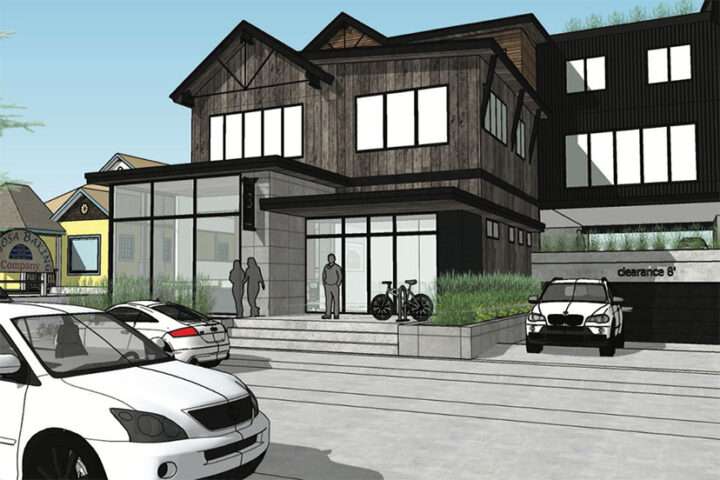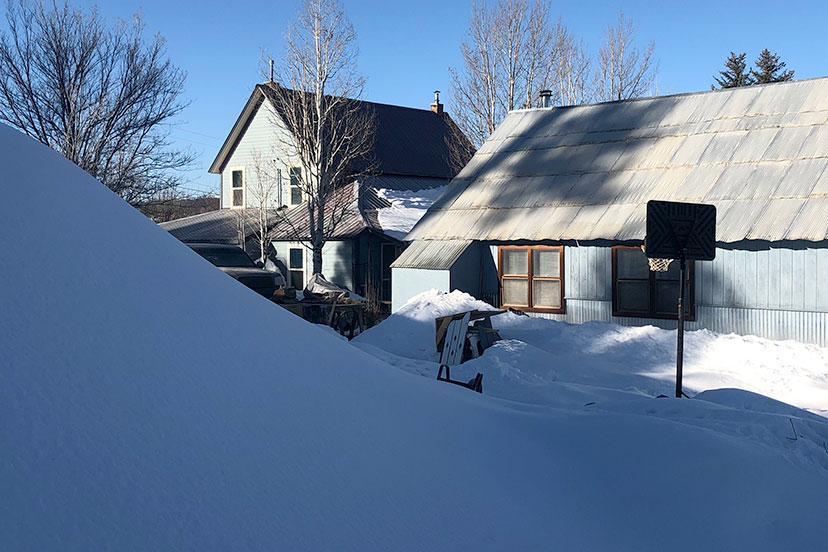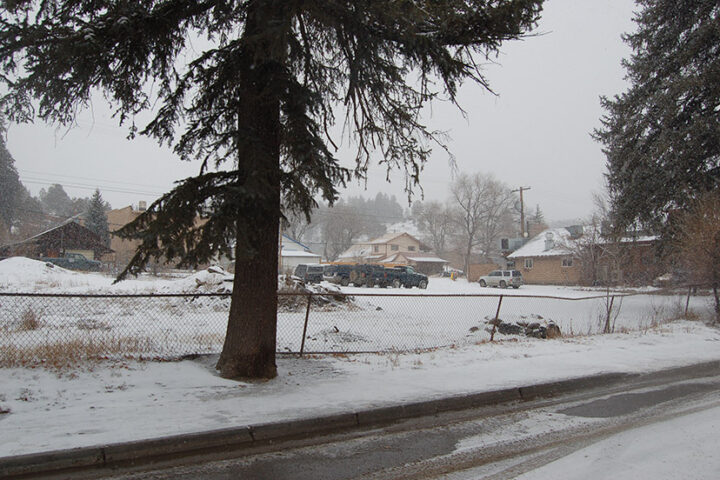PHOTO: The editor’s house in downtown Pagosa Springs, winter, 2023.
My house in downtown Pagosa Springs is now 123 years old. Or I should say, the ‘bones’ are 123 years old. It has undergone a considerable amount of remodeling, including the addition of indoor toilets — probably around 1950 — and electrical wiring — probably around the same time. The original two-story structure had a footprint of about 28 feet by 18 feet… about 1,000 square feet total, which was a fairly large house in 1900, in Archuleta County.
It’s seen several additions since then, and now has about twice the square footage — about 2,000 square feet. Give or take. The occupants include two working adults, two children, and one ‘semi-retired news editor’. Very likely, my family would be hard-pressed to purchase a house like this in Pagosa Springs in 2023, even with three employed adults contributing. And it’s a pretty modest house.
A few blocks away, a development group including Reynolds Ash & Associates and Dirty Rose LLC has proposed a new 43,000 square-foot mixed use structure, to potentially include an office for an architectural firm, a restaurant, and up to eight 1,850 square-foot dwelling units.
Plus two parking garages — an underground garage exiting through the front, and another above it, accessed via the Pagosa Street alley, in the back.
The building’s massive size is partly due to those two parking garages, which are in turn an attempt to meet the Town’s parking requirements. If most of us walked or rode bikes — that is to say, if the Town of Pagosa Springs had actually achieved the “pedestrian friendly, bicycle friendly, walkable downtown” it’s been talking about for the past two decades, then the architectural renderings of 232 Pagosa Street might not have to include two parking garages with a total of 43 garage spaces, and it might not be as oppressively massive compared to the existing neighborhood.

Over half the building’s square footage is allocated to automobiles.
Parking garages are not inexpensive. Especially, perhaps, underground parking garages. I’ve been following the controversy surrounding 232 Pagosa Street for the past several months and I don’t recall anyone mentioning the estimated cost for these two parking garages, but I assume that the developers are trying to make this project ‘pencil’ by going up the maximum allowable height — three stories — and by building luxury residences.
The property in question, 232 Pagosa Street, currently looks like this.
There’s plenty of room on these three parcels for a modest building and a small parking lot. The developers, however, are not being modest.
Here’s architect Brad Ash, addressing the Town Council on February 7, during the Council consideration of the requested ‘density bonus’ that would — if approved — allow a total of eight 1,850-square-foot dwelling units at 232 Pagosa Street.
“I unique part of the way your [density bonus] ordinance is written, is that it doesn’t put a burden on the taxpayers. Developers are not coming to you, asking for money. Everything that’s been done [previously], per Town Council’s desire, has cost the taxpayers money. So I’m going to point that out.”
Mr. Ash makes a valid point. Granting a density bonus does not cost the taxpayers any money, other than the staff time spent negotiating with developers who might be eager to increase the density of their projects. Other types of housing programs often do, indeed, “cost the taxpayers money”.
As a matter of fact, nearly everything the Town government does costs the taxpayers money.
According to the 2023 Town budget, the various taxpayers — most of whom do not actually live within the town — will contribute $1.4 million towards promoting the tourism industry, and will spend another $1.4 million on ‘Parks & Recreation’ plus another $2.7 million in parks and trails improvements.
According to my pocket calculator, that means the Town will spend about $5.5 million on tourism and recreation this year.
That would be ‘taxpayer money’.
Mr. Ash continued explaining why the Town Council should accept the offer to allow Eagle Mountain Development to make an 800-square-foot studio apartment located at 262 Pagosa Street available to a Reynolds Ash & Associates employee, in exchange for a ‘density bonus’ down the street at 232 Pagosa Street of an additional 1,850-square-foot three-bedroom condo unit.
“These density bonuses are important. And the way Ordinance 966 is written, and the reason it was written, is to allow you guys some flexibility to think about how to do this.
“My business has suffered from having applications out; I’ve had signed contracts for people to come work for me, and then show up and say, there’s no housing available.
“We did provide your Planning Department with rendering of the [800-square-foot] studio. It is a high-end studio. A lot of the people we’ve tried to employ at Reynolds Ash are young professionals who make a higher wage than a lot of our locals do, and they can afford that. As a rental, this is a stepping stone for them…
“… you guys might grant this tonight, and say, yes, we support workforce housing. But I’ll be honest with you, we’re still in the process of trying to make this project pencil. And having to provide workforce housing [at 262 Pagosa] to gain a unit [at 232 Pagosa]… there may be enough profit to make the project happen. But that workforce housing is a 30-year burden. But it’s a burden we’re willing to carry because it opens up opportunity for our office…”
We all understand the desire for businesses to make a profit, if they are ‘for-profit’ businesses. And we all understand that tax-funded governments will sometimes bend over backwards to help those for-profit businesses reach their profit projections.
In this particular case, however, the Town Council denied the density bonus request for 232 Pagosa Street, based on a number of reasons put forward by the Council members. The vote was 5-2 to deny the bonus request.
Architect Brad Ash left the meeting following the vote, looking rather disappointed, and, as far as I could tell, without so much as a, “thank you for considering our request”.


